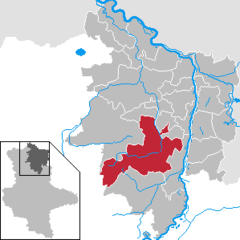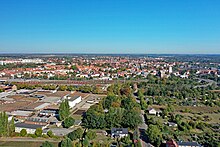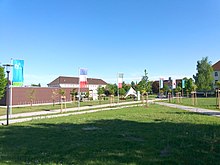Stendal
Stendal | |
|---|---|
 September 2011 view over Stendal with the St. Nicholas Church | |
Location of Stendal within Stendal district  | |
| Coordinates:52°36′N11°51′E/ 52.600°N 11.850°E | |
| Country | Germany |
| State | Saxony-Anhalt |
| District | Stendal |
| Subdivisions | 33 |
| Government | |
| •Mayor(2022–29) | Bastian Sieler[1] |
| Area | |
| • Total | 268.02 km2(103.48 sq mi) |
| Elevation | 31 m (102 ft) |
| Population (2022-12-31)[2] | |
| • Total | 39,105 |
| • Density | 150/km2(380/sq mi) |
| Time zone | UTC+01:00(CET) |
| • Summer (DST) | UTC+02:00(CEST) |
| Postal codes | 39551–39596 |
| Dialling codes | 03931 |
| Vehicle registration | SDL |
| Website | www.stendal.de |
TheHanseatic Cityof Stendal(German pronunciation:[ˈʃtɛndaːl]) is atowninSaxony-Anhalt,Germany.It is the capital of theStendal Districtand the unofficial capital of theAltmarkregion.
Geography
[edit]
Situated west of theElbevalley, the Stendal town centre is located some 125 km (78 mi) west ofBerlin,around 170 km (110 mi) east ofHanover,and 55 km (34 mi) north of the state capitalMagdeburg.Stendal is the seat of a University of Applied Sciences (Fachhochschule) and preserves a picturesqueold townincluding a historic market and several churches. The nearby village Uchtspringe is home to a psychiatric rehabilitation clinic.
Divisions
[edit]The town Stendal consists of Stendal proper and the following 18Ortschaftenor municipal divisions:[3]
- Bindfelde
- Borstel
- Buchholz
- Dahlen
- Groß Schwechten
- Heeren
- Insel
- Jarchau
- Möringen
- Nahrstedt
- Staats
- Staffelde
- Uchtspringe
- Uenglingen
- Vinzelberg
- Volgfelde
- Wahrburg
- Wittenmoor
History
[edit]A settlement namedSteinedalin the EastphalianBalsamgauofSaxony,then a possession ofSaint Michael’s AbbeyinHildesheim,was mentioned in a deed allegedly issued by EmperorHenry IIin 1022. However, the entry has proven to be a 12th-century forgery, as the original document contained no such record. The fortifiedtownnear the Elbe crossing atTangermündewas actually founded and grantedMagdeburg rightsby the firstBrandenburgmargraveAlbert the Bearabout 1160.
The parish church of St Mary's was first mentioned in 1283. Stendal quickly prospered as a centre of commerce and trade; it received city walls about 1300, the citizens joined theHanseatic Leaguein 1358 and purchased the privilege of minting from the Brandenburg margraves in 1369. ALatin schoolis documented from 1338. In 1456 theHohenzollernelectorFrederick II Irontoothfounded a convent ofAugustinian nuns,which today is the site of a museum. In 1502 his descendant ElectorJoachim I Nestormarried PrincessElizabeth of Denmarkat Stendal. Several churches, the town hall and the two remaining city gates show Stendal's wealth in the period.
The Stendal citizens turnedProtestantin 1539, with the reformatorKonrad Cordatusserving assuperintendent.For centuries part of theMargraviate of Brandenburg,Stendal with the Altmark region passed to thePrussianProvince of Saxonyafter theNapoleonic Wars.APrussiangarrison town since the 17th century, it hosted the10th (Magdeburg) Hussarsregiment from 1884.
Stendal was the site of aLuftwaffeairfield in World War II, which had been the site of the first GermanFallschirmjägertraining school from 1936; the boxerMax Schmelingwas trained as a paratrooper here in 1940/41. The town suffered fromstrategic bombing.Stendal was hit by 10 air raids, and more than 300 civilians died when Röxe, a residential area in the southern part of the town, was devastated by bombs.[4]The Cathedral and various historical buildings were heavily damaged by bombs. In April 1945, the aerodrome served as starting place of theSonderkommando Elbeunit, only a few days before the local authorities surrendered to the US Army. On May 4, the commander of the Wehrmacht12th Army,GeneralMaximilian von Edelsheim,signed the capitulation document at the Stendal town hall. In July 1945, Stendal was handed over to Soviet occupation.
From 1949 untilGerman reunificationin 1990, the town belonged toEast Germany,part ofBezirk Magdeburgfrom 1952. Until 1994, the Stendal barracks served as home base for a riflemen division of the Soviet2nd Guards Tank Army.In 1974 the construction of theStendal Nuclear Power Plantwas begun north of the town, but abandoned after reunification. In 2009 the Stendal citizens voted for the prefixHansestadt( "Hanseatic City" ).
On 1 January 2010, the town Stendal absorbed the former municipalitiesBuchholz,Groß Schwechten,Heeren,Möringen,Nahrstedt,Staats,Uchtspringe,Uenglingen,Volgfelde,andWittenmoor.On 29 April 2010, it absorbedVinzelberg,and on 1 September 2010DahlenandInsel.[5]
Education
[edit]
The Magdeburg-Stendal University of Applied Sciences was founded in 1991 and has around 50 study programmes taught at three departments in Magdeburg and two departments in Stendal. There are approximately 130 professors with around 3,700 students in Magdeburg and 1,800 in Stendal.[6]
Main sights
[edit]

There are various well-preserved historical buildings in Stendal, e.g., theTangemünde Gate,a medieval city gate dating from 1220 andUenglinger Gatebuilt in the 15th century.[7]The Powder Tower (Pulverturm) which was built around 1450 is a former defence tower of the medieval city wall.St. Nicholas Churchwas built in 1423-1467 and heavily damaged by bombs in 1945. Reconstruction was started in 1946, interrupted several times and completed in 2013.[8]The City Hall in the Market Place where astatue of Rolandcan be seen was built in the 14th century.St. Mary's Churchwith its two towers measuring 84 metres in height was inaugurated in 1447, and its altar dates from 1471.[9]St. Jakobi Churchin the northern part of the historical centre was built 1311-1477.St. Petri Churchbuilt at the end of the 13th century is the oldest church in Stendal.Breite Straßewith many well-preserved medieval houses is the main street of the old city centre.
Theatre of the Altmark
[edit]The area has a theatre named Theater der Altmark. It was founded in 1946 and has always had a particular involvement in youth and children's theatre. Theatrical performances and dance events are staged, as well as concerts, conferences and meetings.
Winckelmann Museum
[edit]The Winckelmann Museum[10]is named afterJohann Joachim Winckelmann,the founder of classicalarchaeology.Its holdings include biographical documents, works, designs and diagrams as well asGreeksculptures or casts, along with other small artworks from antiquity. Since summer 2003 the museum has been the owner of the world's biggest Trojan horse. With its size of 15.60 m high, 13 m long, 9.50 m wide and its weight of 45 tons it offers a beautiful view over Stendal. Exhibitions are held relating to archaeology and the history of art from the 18th and 19th centuries; there is also a modern art museum. The museum is the seat of the Winckelmann-Gesellschaft (the Winckelmann Society).[11]In addition, the museum has exhibits relating to the history and cultural history of the city of Stendal and of the Altmark dating from the prehistoric period through the area's early history right up to the present. There are exhibits pertaining to the Hanseatic League,Romanesque artand local archaeological material.
Fire Brigade Museum
[edit]The town also has theLandesfeuerwehrmuseum(Fire Brigade Museum), showing the development of fire fighting and protection from the leather bucket to modern fire engines.
Other
[edit]
Stendal is also part of the Altmark cycle path. Information and maps about this cycle path can be had for free from the tourist information office.
Transportation
[edit]Stendal stationis the most importantinterchangeand rail hub in the north of Saxony-Anhalt. Located on theBerlin–Lehrte railwayand the parallelHanover–Berlin high-speed railwayline, it is regularly served byIntercityandIntercity-Express(ICE) trains. Many ICE trains stop in Stendal. Berlin can be reached within 40 minutes andHanoverwithin 50 minutes.[12]
A direct connection to the GermanAutobahnnetwork is planned with the extension of theBAB 14from Magdeburg toSchwerin.
The nearest inland harbour (River Elbe) is inTangermündeabout 15 kms from Stendal.
Twin towns – sister cities
[edit]People
[edit]- Johann Joachim Winckelmann(1717–1768), archaeologist and art historian.[14]
- Johann Christian Dieterich(1722–1800), publisher
- Rudolf Dulon(1807–1870), theologian and revolutionary
- Leo August Pochhammer(1841–1920), mathematician
- Otto Schoetensack(1850–1912), paleoanthropologist
- Richard Zeckwer(1850–1922), composer
- Max Ebert(1879–1929), prehistorian and professor
- Irina Korschunow(1925–2013), writer
- Kurt Liebrecht(born 1936), footballer
- Wilfried Klingbiel(born 1939), footballer
- Gerd Gies(born 1943), politician, prime minister of Saxony-Anhalt
- Heinz-Ulrich Walther(born 1943), figure skater
- Carola Hornig(born 1962), rower
Associated with the town
[edit]- Stendhal(1783–1842), French writer; he lived near Stendal in 1807–08 as an official of the NapoleonicKingdom of Westphalia.According to general belief, he used the aliasStendhalfrom 1817 in homage to Johann Joachim Winckelmann.[15]
Honorary citizens
[edit]- Otto von Bismarck(1815–1898), chancellor, since 1872
- Friedrich Hermann Haacke (1824–1899), physician who dedicated his life to fighting against thecholeraepidemics which affected Stendal in the 19th century. The Haacke-Brunnen, a well in the Sperlingsberg quarter, honours him
- Gustav Nachtigal(1834–1885), doctor and explorer in Africa. He is honored with bust at the Gustav Nachtigal Square
References
[edit]- ^Bürgermeisterwahlen in den Gemeinden, Endgültige Ergebnisse,Statistisches Landesamt Sachsen-Anhalt,accessed 10 November 2022.
- ^"Bevölkerung der Gemeinden – Stand: 31. Dezember 2022"(PDF)(in German).Statistisches Landesamt Sachsen-Anhalt.June 2023.
- ^Hauptsatzung der Hansestadt Stendal,November 2018.
- ^"Angriffe in der Region".
- ^Gebietsänderungen vom 01. Januar bis 31. Dezember 2010,Statistisches Bundesamt
- ^Website - University of Applied Sciences
- ^Karl Baedeker GmbH:Deutschland 2000,p.97. Ostfildern 2000
- ^"Dom St. Nikolaus, Stendal".
- ^"Tourist-Information der Hansestadt Stendal: Marienkirche".
- ^Winckelmann Museum
- ^Winckelmann-Gesellschaft
- ^"Stendal - Alte Hansestadt und Stadt der Backsteingotik".
- ^"Partnerstädte".stendal.de(in German). Stendal.Retrieved2021-04-01.
- ^Sime, James;Mitchell, John Malcolm (1911)..Encyclopædia Britannica.Vol. 28 (11th ed.). p. 707.
- ^.Encyclopædia Britannica.Vol. 3 (11th ed.). 1911. pp. 838–839.
External links
[edit]- Official website
 (in German)
(in German)




